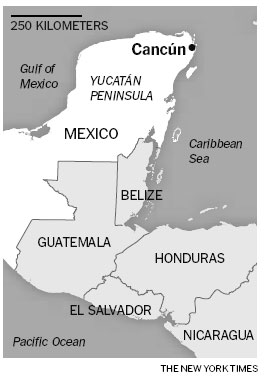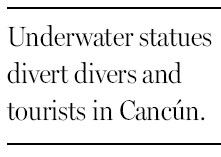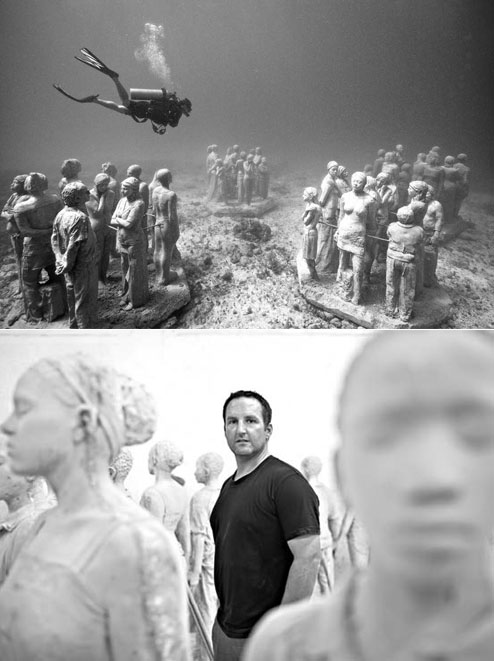Ghostly protectors for a vulnerable reef
Updated: 2012-08-26 08:00
By Randal C. Archibold(The New York Times)
|
|||||||
|
The Mesoamerican Reef, the world's second-largest barrier reef system, is near Cancun, Mexico. Top, statues in the water off Cancun were installed to draw divers away from the reef. The artist Jason deCaires, below. |
CANCUN, Mexico - Jason deCaires Taylor labors over his sculptures for weeks, 4.5-metric-ton concrete figures of men, women and children, many of them modeled after people in the fishing village near here where he lives and works. The little boy Carlito sitting on a rock. The proud Joaquin glancing skyward.
In a stifling warehouse he fusses over their lips and noses. Gets the hair just right. Adjusts their clothing.
Then he sinks them in the sea.
There, they rest in ghostly repose in the Museo Subacuatico de Arte, serving as both a tourist attraction and a conservation effort by drawing divers and snorkelers away from the Mesoamerican Reef, the second-largest barrier reef system in the world, and toward this somewhat macabre, artificial one.
The nearly 500 statues, the first ones placed in 2009, have acquired enough coral, seaweed and algae to give them the look of zombies. In six years or so, the coral will overtake them.
"Foremost, it's an opportunity to view this other world," Mr. Taylor said. "We are surrounded by water, but people have no understanding what their planet is. It helps see ourselves as part of the world."

Mr. Taylor places the works, anchored with special sand bolts, in water shallow enough for snorkelers to get a view, but divers get the most out of it, with close-ups of the rainbow swirl of coral and algae. At night, Mr. Taylor said, a family of sea turtles has been known to go sightseeing.
Mr. Taylor, who uses marine-grade concrete specially prepared to entice coral and be close to neutral pH, contends that the works help preserve the natural reef by diverting divers away from it.
Some scientists agree.
"If it is not so extensive that it impinges hugely on the natural reef, it does help by providing an alternative dive site," said Richard E. Dodge, executive director of the National Coral Reef Institute in Florida.
Others are more skeptical, saying that the reef is harmed more by pollution from the resorts and by climate change than by visitors to it.
Mr. Taylor, a 37-year-old Briton, was drawn to Mexico after an earlier project off the Caribbean island of Grenada got a lot of attention.
That $50,000 project, financed with his own savings, grew into an underwater park of 65 works, a collection that includes the oft-photographed "Lost Correspondent" - a lonely man typing at his desk in the vast blue water.
That project drew the attention of the National Marine Park, an aquatic preserve off Cancun visited by about 750,000 people annually. They had started building small artificial reefs to lure people away from the damaged natural one, and, with federal financing, they wanted Mr. Taylor to design thousands of sculptures.
It seemed natural to use local residents as models, Mr. Taylor said. He subjected the volunteers to a two-hour molding process.

"I was afraid when they started covering me," said Joaquin Adame Sutter, a 53-year-old fisherman. "I said let's do my body first, and tomorrow you can do my face. It was a funny feeling, you know."
Mr. Taylor's photographs and sculptures were exhibited in July by the Jonathan LeVine Gallery in New York. Still, a dream project he is developing in his head would hardly be accessible, an antidote to the wide exposure of his art. It would be a provocative political work (he declined to give specifics) that would be submerged in the deep sea in an unspecified ocean, to be seen only, perhaps, in photographs.
"So much of life is built around myth," he said, hinting at the message. "I would put it so a hundred ships would never find it."
The New York Times
(China Daily 08/26/2012 page10)
